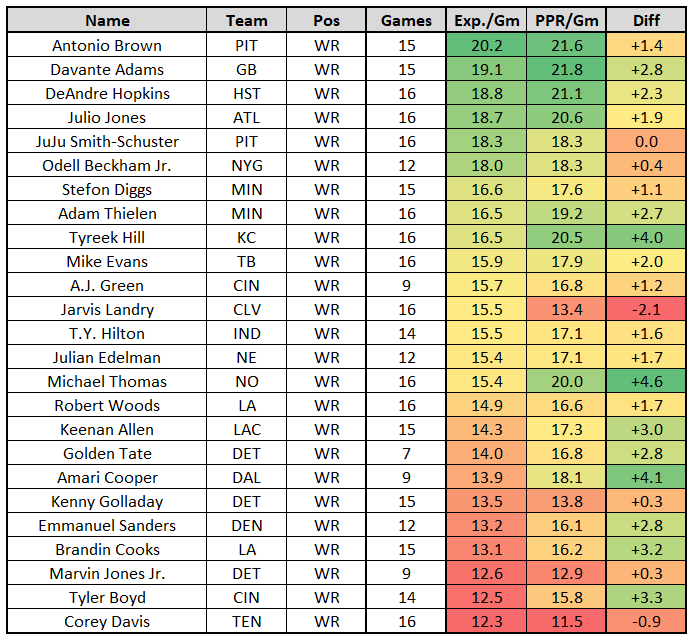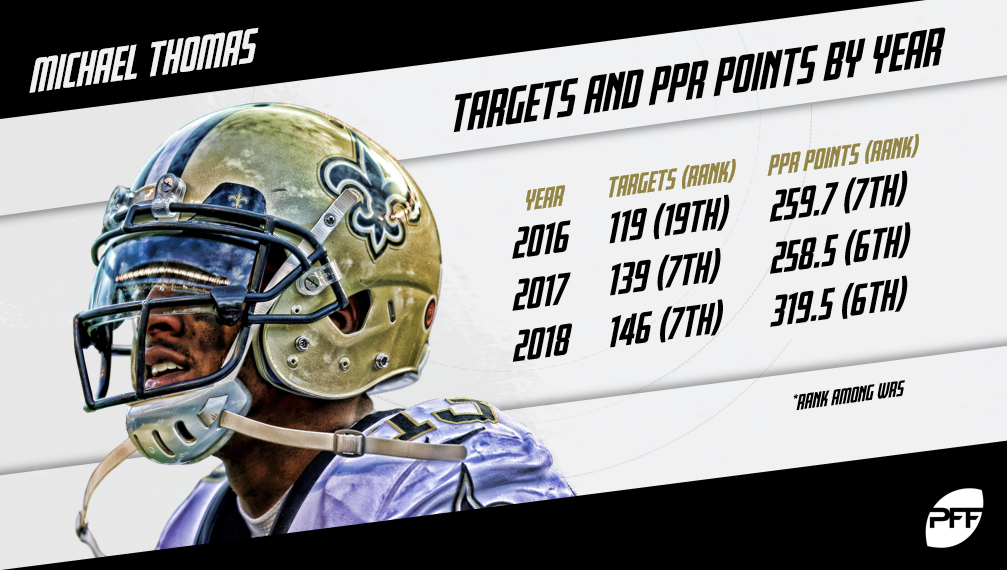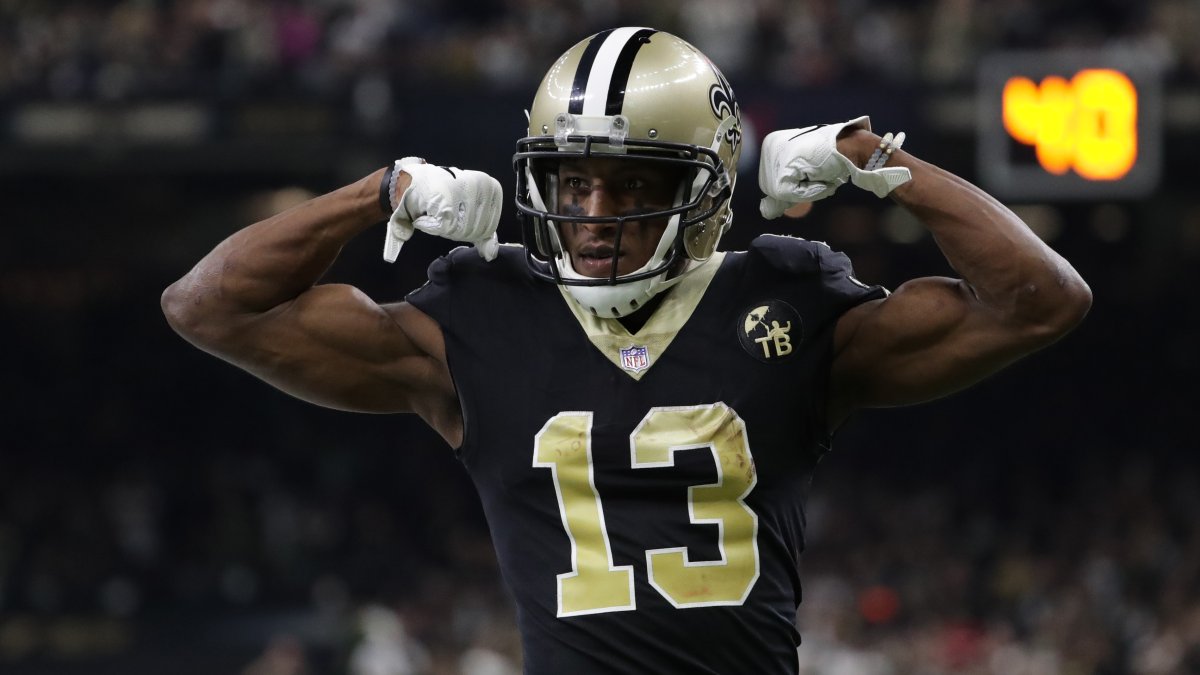Which wide receivers saw the best volume in 2018? Which wide receivers will have the most-valuable workload in 2019? Which wide receivers were the most or least-efficient at scoring fantasy points relative to opportunity? All of these questions can be answered simply using just one stat — expected fantasy points.
Below, we’ll be taking an in-depth look at the wide receiver position through the lens of this metric and analyzing what this means for the 2019 fantasy season.
2018 was another down year for wide receivers in terms of volume. By total expected fantasy points at the position, this was the second-lowest output over the past seven seasons (but still better than 2017). Antonio Brown totaled 20.2 expected fantasy points per game in 2018, which ranks 12th-best over the past decade, but no other wide receiver ranked top-20. Otherwise, you’ll notice the top of our chart has remained similar to years past (Brown, DeAndre Hopkins, Julio Jones, Odell Beckham Jr. all ranking top-six).
See below for a list of the wide receivers who ranked top-25 in expected fantasy points per game followed by an in-depth look at some of the highlights.

JuJu Smith-Schuster, WR, Pittsburgh Steelers
Antonio Brown, WR, Oakland Raiders
A fun debate this offseason has been “Which of these two wide receivers, should be drafted first?” That’s a fun debate, but not an easy one. Last season, Brown led all wide receivers in expected fantasy points per game with 20.2. This ranks 12th-best by any wide receiver this past decade and eclipses Smith-Schuster’s total by 2.2. Over the past five seasons, Brown has ranked first, first, second, second, and second in expected fantasy points per game. He also trumped Smith-Schuster in per-game efficiency last year (+1.4 to +0.0). Excluding touchdowns, Smith-Schuster was actually the far more efficient of the two, which means he was probably far more unlucky than bad. Last season, Brown outscored his touchdown expectation by 3.8 (fourth-most), while Smith-Schuster fell 2.6 touchdowns short of his expectation (third-worst). Both numbers should regress closer to the mean next season.
It’s hard to project what Brown’s volume might look like in Oakland, but history suggests he’ll again rank near the top. Smith-Schuster might see the same volume he saw last year, the same volume Brown saw last year, or something even better than that. Smith-Schuster ranked 11th in expected fantasy point market share last season (21.9%), while Brown leaves behind a vacated 24.0% market share, which ranked fifth. It’s hard to imagine all of that goes to some combination of Vance McDonald and the other wide receivers. If I had to guess, I’d say Smith-Schuster sees better volume than Brown next year, though efficiency will be more suspect if Smith-Schuster doesn’t continue to draw the majority of his routes from the slot (62% last year). If that’s the case, Smith-Schuster will face a much tougher cornerback schedule than what he saw last year. Currently, I have Smith-Schuster as the WR6 in my own rankings, with Brown right behind him at WR7.
Stefon Diggs/Adam Thielen, WR, Minnesota Vikings
Through Minnesota’s first six games, Thielen led all wide receivers in expected fantasy points per game (21.8), well above Diggs (15.7). Over Minnesota’s last 10 games, those splits flipped, with Diggs averaging 17.0 expected fantasy points per game to Thielen's 13.3. Diggs ultimately bested Thielen in volume across the full season (16.6 to 16.5), though both finished top-10, and Thielen was far more efficient (+2.7 to +1.1) and productive (19.2 to 17.6). Who is the true WR1 on this team? Who should be drafted first in 2019? Your guess is as good as mine, though I have both neck-and-neck in my rankings as low-end WR1s.
A.J. Green/Tyler Boyd, WR, Cincinnati Bengals
Last season, Green ranked 11th in expected (15.7) and 18th in actual fantasy points per game (16.8). Boyd ranked 14th (12.5) and 22nd (15.8). At ADP, I’m much more a buyer of Green (WR13) than Boyd (WR27). Green has ranked top-12 in expected fantasy points per game in seven of his eight career seasons. Though I prefer Green, that doesn’t mean Boyd isn’t also a strong value at ADP. He actually saw more volume (13.0 to 11.5) and was more productive (17.4 to 12.8) in games Green was active last year.
Julian Edelman, WR, New England Patriots
(EFP: 15.4, PPR: 17.1)
How’s this for consistent? Over the past six seasons, Edelman has ranked 14th, N/A, 15th, 14th, 16th, and 14th in expected fantasy points per game. On top of that, Edelman was our sixth-most-consistent player (by this metric) on a week-to-week-basis last season. I think, either we should expect these numbers to climb in 2019, or some other New England receiver is going to be a massive value this year. Last season, Rob Gronkowski, Chris Hogan, and Josh Gordon comprised a 36% receiving expected fantasy point market share. Assuming Gordon doesn’t return, only one team lost a larger percentage of its receiving market share – the Ravens at 39% (keep that in mind regarding Marquise Brown’s lowly ADP).
Michael Thomas, WR, New Orleans Saints
(EFP: 15.4, PPR: 20.0)

Thomas is something of an anomaly by our data. Over the past three seasons he’s ranked sixth, seventh, and seventh in fantasy points per game. By expected fantasy points per game, he’s ranked 15th, 11th, and 21st. What Thomas lacks in volume he makes up for in efficiency, ranking second (behind only Tyreek Hill) in expected fantasy points per game over expectation (+3.2) across these three seasons.
In most cases, we’d look at this and project an incoming regression to the mean, but, I think, not in Thomas’ case. Thomas might just be one of these players (like Rob Gronkowski, Jordy Nelson, or DeSean Jackson) who is so good that he needs to be treated like an outlier. Projecting a regression to the mean works in most cases, but if you treat every player like this, you’re going to miss out on league-winning talents (like Odell Beckham Jr., Tyreek Hill, Doug Baldwin, and the other three we already mentioned). Further, Drew Brees has a long history of uplifting his top receivers to hyper-efficient heights.
Corey Davis, WR, Tennessee Titans
(EFP: 12.3, PPR: 11.5)
Last season, Davis ranked 15th at the position in expected fantasy point market share (20%), 25th in expected fantasy points per game (11.4), and 40th in actual fantasy points per game. All three numbers are below his current ADP (WR41), which implies good value. I think that’s true, though I’m not entirely sold on Davis as a talent. Davis totals -46.2 fantasy points below his expectation over the past two seasons, which ranks eighth-worst over this span. If he were to see the same volume he saw last year, he’d be a great ADP value, but that seems unlikely given how poorly he’s performed, as well as the healthy return of Delanie Walker and the arrival of rookie A.J. Brown (who I’m particularly high on).
Tyler Lockett, WR, Seattle Seahawks
(EFP: 7.8, PPR: 13.8)
Lockett ranked 26th in fantasy points per game last season (13.8), but, absurdly, ranked just 82nd in expected fantasy points per game (7.8). In total, he outscored his expectation by 95.4 fantasy points, or, the second-most by any wide receiver over the past decade. On a per-target basis, it’s the most efficient season I’ve ever recorded. These numbers all scream regression to the mean, but even less so than the fact he outscored his touchdown expectation by 6.2 (the fifth-largest positive differential this past decade). However, Doug Baldwin consistently ranked as one of our most efficient wide receivers per this metric. Perhaps Lockett can simultaneously be due for a regression while also being a fine value by ADP as Seattle’s new hyper-efficient WR1.
Cooper Kupp, WR, Los Angeles Rams
(EFP: 10.7, PPR: 16.9)
On a per-game basis last year, Kupp was even more efficient than Lockett, scoring 6.2 fantasy points per game over his expectation (the second-best mark this past decade). Last season, Kupp averaged 16.6 fantasy points per game, which ranked 14th among wide receivers. If we exclude games he left early due to injury, that number jumps to 20.6, which would have ranked fifth-best last year. Still, even if adjusting for those injury weeks, he averaged only 12.6 expected fantasy points per game, which would have ranked 23rd overall and third among the wide receivers on his own team. He’s another glaring regression candidate, but ultimately didn’t fall too far in my own rankings (WR19). He’ll remain a focal point of the offense, and maybe even more so than last year, after seeing how much QB Jared Goff struggled without him.
Mike Williams, WR, Los Angeles Chargers
(EFP: 8.1, PPR: 11.1)
Williams is another regression candidate, but one I’m far less excited to own. Last season, he ranked 45th in fantasy points per game (11.1) and 75th in expected fantasy points per game (8.1). He currently ranks 26th at the position in ADP. Williams has to contend with Hunter Henry’s return to the lineup and will need to be less reliant on touchdowns than he was last year if he wants to come close to returning value at his lofty ADP.
Last season, Williams scored 10 touchdowns (fifth-most among wide receivers) but averaged just 41.5 receiving yards per game (55th). In total, 33% of his fantasy points came on touchdowns, which ranked third-most among wide receivers. That looks all the more alarming after realizing his near-end zone volume wasn’t nearly as good as his production implied. He scored 4.6 touchdowns above his expectation (6.4 touchdowns, 19th), which ranks as the 18th-largest positive differential this past decade. I don’t expect to be drafting Williams at all this year.
DeSean Jackson, WR, Philadelphia Eagles
(EFP: 12.1, PPR: 12.6)
Jackson saw good volume last year, ranking 28th in expected fantasy points per game (12.1) but was only moderately efficient (+0.5). He struggled with efficiency, at least comparably so to the rest of his career, while in Tampa Bay. Perhaps he's lost a step at age 32, though, I think more than likely this had to do with Jameis Winston’s struggles with deep accuracy. After all, he was our 18th-highest-graded wide receiver (of 146 qualifiers) over this stretch. Over Jackson's previous four seasons, he outscored his expectation by 173.0 fantasy points, which ranked behind only Antonio Brown.
Other/notes
- DeAndre Hopkins led the position in expected fantasy point market share with 27.2%, which also ranks seventh-most this past decade, behind his 2017 (29.6%) and 2015 (28.1%) seasons.
- Odell Beckham Jr. has ranked top-six in expected fantasy points per game in every year of his career.
- Julio Jones has ranked top-four in expected fantasy points per game in four of his last five seasons.
- Over the past three seasons, our most-efficient wide receivers in terms of total differential are (in order): Tyreek Hill, Michael Thomas, Davante Adams, Brandin Cooks, Tyler Lockett, and Adam Thielen.
- Over the past two seasons, DeVante Parker ranks fourth-worst, Josh Doctson fifth-worst, and John Brown seventh-worst in expected fantasy point differential. All are players I’m avoiding at ADP.
- Last season, in games active, Robert Woods led Los Angeles' receivers in expected fantasy point market share (20.3%), followed by Brandin Cooks (18.0%), and then Cooper Kupp (14.7%). These numbers ranked (respectively) 14th, 26th, and 47th among all wide receivers last year.
- Perhaps even more so than Mike Williams, Calvin Ridley is another glaring regression candidate. He scored 5.0 touchdowns over his expectation in 2018, the 12th-largest differential this past decade. Though volume will likely be better next season, he’s due for a massive efficiency regression.
- Last season, Kenny Golladay averaged 11.9 expected fantasy points per game when Marvin Jones was active but 13.9 expected fantasy points per game when he was out of the lineup. Jones ranks 23rd and 20th in expected fantasy points per game over the past two seasons.
- Mike Evans was pretty efficient last season, and especially so by his standards, averaging 1.9 fantasy points per game over his expectation. Across his previous three seasons he averaged a near-league-low 2.7 fantasy points per game below his expectation.
- Jarvis Landry scored 34.2 fantasy points below his expectation in 2018. The three wide receivers who ranked worse are all currently free agents. I’d expect the arrival of Odell Beckham Jr. to help with efficiency but with hurt volume in 2019.



 © 2025 PFF - all rights reserved.
© 2025 PFF - all rights reserved.